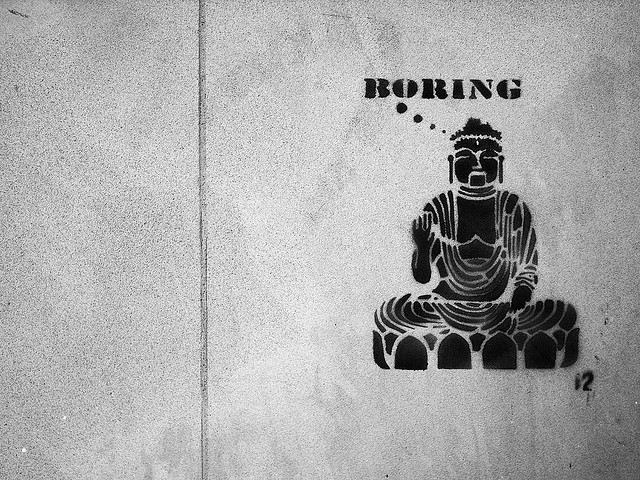I started teaching yoga about six months ago and ever since my first class, this one question has been haunting my thoughts.
It’s an issue that never crossed my mind before because when it comes to my own yoga practice, I am the prototype Savasana nerd.
From experience I know now that certainly not everybody in Corpse Pose actually has their eyes shut all the time. But when it’s me enjoying the final relaxation, I actually try to practice sensory withdrawal. While not listening to the loud truck thundering by or ignoring the mosquito that is sucking blood through my sweaty skin may not always be 100% successful, there is one thing I always manage: I keep my eyes closed and I try to focus on myself.
As a result, I have never during the hundreds of savasanas I’ve enjoyed, wondered nor known what the teacher does during those final moments of total peace and quiet. Except of course for the ones that give massages, wave around with bottles of fragrant oil or talk you through total relaxation.
What does the teacher do that you cannot hear nor feel?
Perhaps she sits there picking her nose, finally able to get rid of that booger she felt tickling in her nostril with each inhale.
Or maybe she does some comparative boob analysis, scanning all the breasts lolling to the left and right. Alternatively he may be taking sneaky silent pictures of his students to post on Instagram. Or he’s just sitting there, bored, waiting for the ticking clock to bring deliverance.
But this is all in my imagination.
I only know for sure what I do when my students are restoring their energies after I’ve finally whispered they can lie down and let it all go.
So here is what I, the new eager beaver teacher, does during Savasana. May this little list be of help to other beginning instructors.
1) Verbal guidance
Especially when I have a class with beginners or when I feel that there is still a lot of scattered energy around, I talk them down. Either by doing a body scan and reminding them to relax each and every body part or by inviting them to visualise and focus on something, such as their breath flowing in and out.
Sometimes however, I feel I’ve talked enough already and I simply shut up and leave them alone.
2) Hands-on
Depending on the vibrations in the room and my own level of energy, I give my students a little “alignment massage” as I like to call it. I gently pull their legs (literally) and sway them from side to side, straighten their arms and pull their shoulders down, rub their neck and align their head. Sometimes, I add a little head and third eye massage. This of course, is not my own invention but simply an application of what some wonderful teachers have given me during Savasana.
I do not feel that it’s always appropriate though, sometimes for lack of time, occasionally because it feels better to leave the students in control of their own body.
3) Meditation
It happens, especially after a physically or mentally heavy class, that I feel I need my moment of relaxation too. I don’t however, find it fitting to collapse next to my students and play dead with them. So I sit in Lotus or Half-Lotus in front of the class, facing the students, my hands in Jnana Mudra, drishti at the tip of my nose. This way, I can still sense and see if anything is happening among my students, yet I have the opportunity to center myself and let my mind and body integrate all the energy that is swirling around.
On some occasions, especially after a yoga therapy class, I feel the urge to send some extra positive energy towards my client, so I meditate and focus on him or her.
4) Observation
It happens that I have nothing to give anymore to my students, nor that I have the need for personal attention. In those cases, I simply observe the beautiful people resting in front of me.
I notice how the girl who was so restless and unfocussed at the beginning, is now utterly still and breathing smoothly, her body grateful after a dynamic and flowing session. I see how the fingers and toes of the otherwise immobile older lady are twitching, telling me her energy meridians are not yet in balance, even though she may feel relaxed after her private yoga therapy session.
I hear the thoughts of the stressed manager who barged into the class five minutes late and is anxiously waiting for me to signal the end of the class because her phone has vibrated three times already during the Yin class. I feel the uneven breathing of the guy who was struggling and sweating profusely throughout the practice, confirming that his choice to take up yoga for beginners was a wise decision.
I look and I learn.
Yet whatever I choose to do during my students’ Savasana, I always end up wishing that I could let them lie there for another endless moment as I breathe with them and share in their gratitude, relief and dedication.
And still, I wonder what all the other teachers out there do. So maybe, just maybe, I’ll take a sneaky peak next time I’m taking rest.
Love elephant and want to go steady?
Sign up for our (curated) daily and weekly newsletters!
Editor: Travis May
 Share on bsky
Share on bsky






Read 20 comments and reply